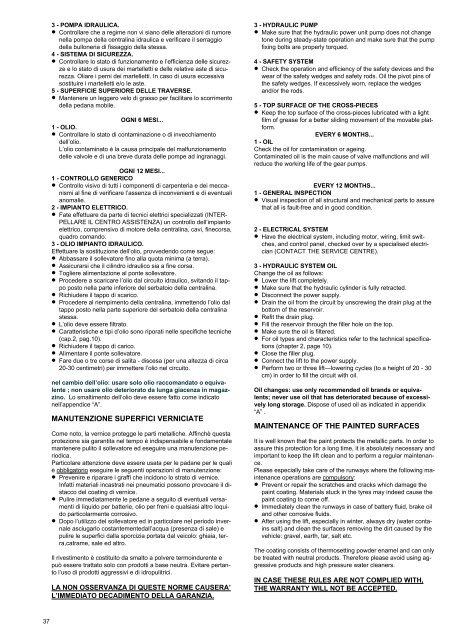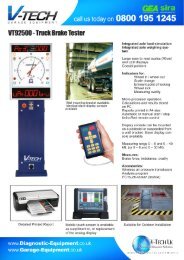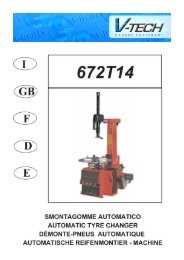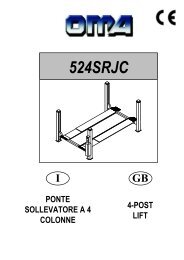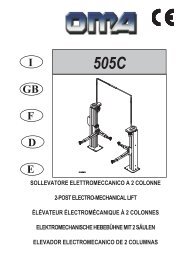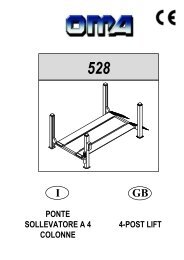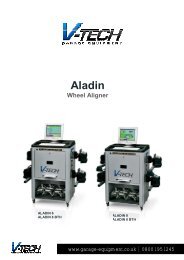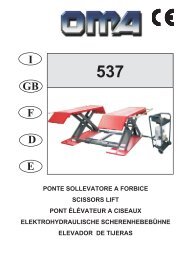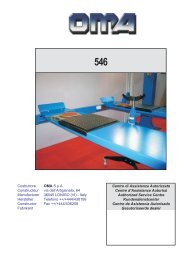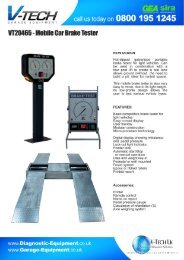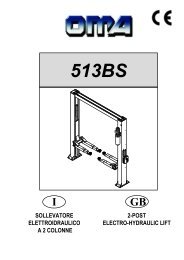526LT-ALT - R16 - V-Tech Garage Equipment
526LT-ALT - R16 - V-Tech Garage Equipment
526LT-ALT - R16 - V-Tech Garage Equipment
Create successful ePaper yourself
Turn your PDF publications into a flip-book with our unique Google optimized e-Paper software.
3 - POMPA IDRAULICA.<br />
Controllare che a regime non vi siano delle alterazioni di rumore<br />
nella pompa della centralina idraulica e verificare il serraggio<br />
della bulloneria di fissaggio della stessa.<br />
4 - SISTEMA DI SICUREZZA.<br />
Controllare lo stato di funzionamento e l’efficienza delle sicurezze<br />
e lo stato di usura dei martelletti e delle relative aste di sicurezza.<br />
Oliare i perni dei martelletti. In caso di usura eccessiva<br />
sostituire i martelletti e/o le aste.<br />
5 - SUPERFICIE SUPERIORE DELLE TRAVERSE.<br />
Mantenere un leggero velo di grasso per facilitare lo scorrimento<br />
della pedana mobile.<br />
OGNI 6 MESI...<br />
1 - OLIO.<br />
Controllare lo stato di contaminazione o di invecchiamento<br />
dell’olio.<br />
L’olio contaminato è la causa principale del malfunzionamento<br />
delle valvole e di una breve durata delle pompe ad ingranaggi.<br />
OGNI 12 MESI...<br />
1 - CONTROLLO GENERICO<br />
Controllo visivo di tutti i componenti di carpenteria e dei meccanismi<br />
al fine di verificare l’assenza di inconvenienti e di eventuali<br />
anomalie.<br />
2 - IMPIANTO ELETTRICO.<br />
Fate effettuare da parte di tecnici elettrici specializzati (INTER-<br />
PELLARE IL CENTRO ASSISTENZA) un controllo dell’impianto<br />
elettrico, comprensivo di motore della centralina, cavi, finecorsa,<br />
quadro comando.<br />
3 - OLIO IMPIANTO IDRAULICO.<br />
Effettuare la sostituzione dell’olio, provvedendo come segue:<br />
Abbassare il sollevatore fino alla quota minima (a terra).<br />
Assicurarsi che il cilindro idraulico sia a fine corsa.<br />
Togliere alimentazione al ponte sollevatore.<br />
Procedere a scaricare l’olio dal circuito idraulico, svitando il tappo<br />
posto nella parte inferiore del serbatoio della centralina.<br />
Richiudere il tappo di scarico.<br />
Procedere al riempimento della centralina, immettendo l’olio dal<br />
tappo posto nella parte superiore del serbatoio della centralina<br />
stessa.<br />
L’olio deve essere filtrato.<br />
Caratteristiche e tipi d’olio sono riporati nelle specifiche tecniche<br />
(cap.2, pag.10).<br />
Richiudere il tappo di carico.<br />
Alimentare il ponte sollevatore.<br />
Fare due o tre corse di salita - discesa (per una altezza di circa<br />
20-30 centimetri) per immettere l’olio nel circuito.<br />
nel cambio dell’olio: usare solo olio raccomandato o equivalente<br />
; non usare olio deteriorato da lunga giacenza in magazzino.<br />
Lo smaltimento dell’olio deve essere fatto come indicato<br />
nell’appendice “A”.<br />
MANUTENZIONE SUPERFICI VERNICIATE<br />
Come noto, la vernice protegge le parti metalliche. Affinchè questa<br />
protezione sia garantita nel tempo è indispensabile e fondamentale<br />
mantenere pulito il sollevatore ed eseguire una manutenzione periodica.<br />
Particolare attenzione deve essere usata per le padane per le quali<br />
è obbligatorio eseguire le seguenti operazioni di manutenzione:<br />
Prevenire e riparare i graffi che incidono lo strato di vernice.<br />
Infatti materiali incastrati nei pneumatici possono provocare il distacco<br />
del coating di vernice.<br />
Pulire immediatamente le pedane a seguito di eventuali versamenti<br />
di liquido per batterie, olio per freni e qualsiasi altro loquido<br />
particolarmente corrosivo.<br />
Dopo l’utilizzo del sollevatore ed in particolare nel periodo invernale<br />
asciugarlo costantementedall’acqua (presenza di sale) e<br />
pulire le superfici dalla sporcizia portata dal veicolo: ghiaia, terra,catrame,<br />
sale ed altro.<br />
Il rivestimento è costituito da smalto a polvere termoindurente e<br />
può essere trattato solo con prodotti a base neutra. Evitare pertanto<br />
l’uso di prodotti aggressivi e di idropulitrici.<br />
LA NON OSSERVANZA DI QUESTE NORME CAUSERA’<br />
L’IMMEDIATO DECADIMENTO DELLA GARANZIA.<br />
3 - HYDRAULIC PUMP<br />
Make sure that the hydraulic power unit pump does not change<br />
tone during steady-state operation and make sure that the pump<br />
fixing bolts are properly torqued.<br />
4 - SAFETY SYSTEM<br />
Check the operation and efficiency of the safety devices and the<br />
wear of the safety wedges and safety rods. Oil the pivot pins of<br />
the safety wedges. If excessively worn, replace the wedges<br />
and/or the rods.<br />
5 - TOP SURFACE OF THE CROSS-PIECES<br />
Keep the top surface of the cross-pieces lubricated with a light<br />
film of grease for a better sliding movement of the movable platform.<br />
EVERY 6 MONTHS...<br />
1 - OIL<br />
Check the oil for contamination or ageing.<br />
Contaminated oil is the main cause of valve malfunctions and will<br />
reduce the working life of the gear pumps.<br />
EVERY 12 MONTHS...<br />
1 - GENERAL INSPECTION<br />
Visual inspection of all structural and mechanical parts to assure<br />
that all is fault-free and in good condition.<br />
2 - ELECTRICAL SYSTEM<br />
Have the electrical system, including motor, wiring, limit switches,<br />
and control panel, checked over by a specialised electrician<br />
(CONTACT THE SERVICE CENTRE).<br />
3 - HYDRAULIC SYSTEM OIL<br />
Change the oil as follows:<br />
Lower the lift completely.<br />
Make sure that the hydraulic cylinder is fully retracted.<br />
Disconnect the power supply.<br />
Drain the oil from the circuit by unscrewing the drain plug at the<br />
bottom of the reservoir.<br />
Refit the drain plug.<br />
Fill the reservoir through the filler hole on the top.<br />
Make sure the oil is filtered.<br />
For oil types and characteristics refer to the technical specifications<br />
(chapter 2, page 10).<br />
Close the filler plug.<br />
Connect the lift to the power supply.<br />
Perform two or three lift—lowering cycles (to a height of 20 - 30<br />
cm) in order to fill the circuit with oil.<br />
Oil changes: use only recommended oil brands or equivalents;<br />
never use oil that has deteriorated because of excessively<br />
long storage. Dispose of used oil as indicated in appendix<br />
“A” .<br />
MAINTENANCE OF THE PAINTED SURFACES<br />
It is well known that the paint protects the metallic parts. In order to<br />
assure this protection for a long time, it is absolutely necessary and<br />
important to keep the lift clean and to perform a regular maintenance.<br />
Please especially take care of the runways where the following maintenance<br />
operations are compulsory:<br />
Prevent or repair the scratches and cracks which damage the<br />
paint coating. Materials stuck in the tyres may indeed cause the<br />
paint coating to come off.<br />
Immediately clean the runways in case of battery fluid, brake oil<br />
and other corrosive fluids.<br />
After using the lift, especially in winter, always dry (water contains<br />
salt) and clean the surfaces removing the dirt caused by the<br />
vehicle: gravel, earth, tar, salt etc.<br />
The coating consists of thermosetting powder enamel and can only<br />
be treated with neutral products. Therefore please avoid using aggressive<br />
products and high pressure water cleaners.<br />
IN CASE THESE RULES ARE NOT COMPLIED WITH,<br />
THE WARRANTY WILL NOT BE ACCEPTED.<br />
37


